The Secretary of the Maryland Department of Natural Resources, pursuant to Code of Maryland Regulation 08.02.05.12F, has announced the season, catch limit, and minimum size for the summer flounder fishery for 2016, effective 12:01 a.m. January 1, 2016.
The season will be open January 1, 2016 through December 31, 2016.
Recreational anglers may keep up to 4 summer flounder per person per day.
The recreational minimum size for summer flounder is 16 inches in all Maryland state waters.
The commercial hook and line minimum size for summer flounder is 16 inches in all Maryland state waters other than the study area described in COMAR 08.02.05.12G, where the minimum size is 14 inches during the study period.
The commercial minimum size for summer flounder caught by gear other than hook and line is 14 inches.
All other rules remain the same.
Monday, December 21, 2015
Thursday, December 17, 2015
Keith Lockwood's Maryland Fishing Report
More than a few have been taking advantage of the mild weather and late season fishing action. Unseasonably warm weather and light winds have made for some excellent fishing opportunities out on the open waters of the Chesapeake Bay and Atlantic Ocean as well as smaller freshwater areas. Colder weather is sure to be upon us in the near future so don't miss out.
Anyone fishing in the Conowingo Dam pool or the lower Susquehanna can't help but notice there has been very little water coming through the dam in the past couple of months. This has generally been a good thing for the bay's water clarity. Upper bay fishing for striped bass is toning down as one would expect as we approach the end of December. Balmy days and calm winds are enticing anglers to continue trolling along channel edges with a mixed spread of medium sized lures and larger presentations for a chance at one of the large fall migrant striped bass that have been frequenting the channel edges just above the Bay Bridge and the Dumping Grounds. A mix of bucktails, swim shads, parachutes and spoons have all come into play and all are being pulled behind large inline weights to get down to where the fish are holding along 35' to 40' channel edges.
Breaking fish action is pretty sparse these days in the upper bay since most of the bay anchovies and small menhaden have moved farther south looking for warmer water conditions. There are some nice sized striped bass holding along channel edges at the mouths of the major tidal rivers and main bay channels but they tend to be spread thin so trolling has been the most productive option. The Bay Bridge and the Key Bridge are two exceptions where jigging and live lining eels has been productive near the bridge piers. White perch can also be used for live lining as Rich Watts proves with this nice striped bass caught along a channel edge with a live perch.
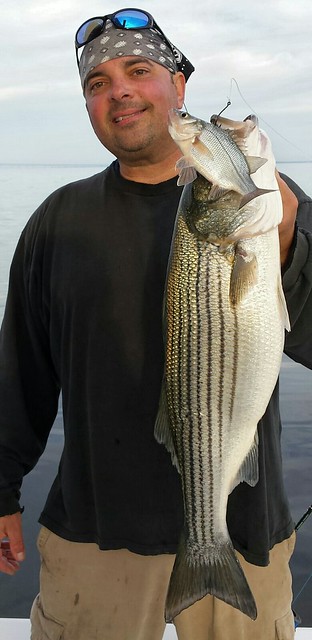
Photo by Angelina Watts
White perch are holding deep in many of the channel areas of the upper bay and near the Bay Bridge. When they can be spotted on a depth finder; jigging or using a bottom rig baited with pieces of bloodworms are good options. Yellow perch fishing has improved in the upper bay in many of the tidal rivers such as the upper Bush, Northeast and lower Susquehanna. Small minnows on a bottom rig or small jigs are good baits to use. As upper bay tidal river waters become colder the yellow perch will be found in increasingly deeper waters.
In the middle bay region there are still plenty of striped bass to be found along main channel edges on the western and eastern sides of the bay. Classic steep channel edges such as Bloody Point, the False Channel at the mouth of the Choptank on the eastern side and the west side of the shipping channel from Breezy Point south. A mix of school sized and large fall migrant striped bass are being found along these edges in about 40' of water. Large lures such as Mojos, bucktails and parachutes dressed with sassy shads have been the most popular choices when trying to entice a large fall migrant. Medium sized bucktails, swim shads and spoons have been popular choices for school sized fish either in tandem or behind umbrella rigs. All are being pulled behind inline weights to get them down to where the fish are holding. Keith Stouffer caught this beautiful 40 lb striped bass on the steep channel edge at Bloody Point by trolling a large parachute dressed with a sassy shad.

Photo Courtesy of Keith Stouffer
At times the striped bass that are suspended near the channel edges are concentrated enough that light tackle jigging can be productive. In many areas the fish tend to be holding near the 40' edges of the shipping channel. In most cases with light winds and calm waves 2 to 3 ounce metal or soft plastic jigs are enough to get down to the fish. White perch are also often holding in these same water depths and the larger perch will hit the metal jigs at times.
The lower bay offers some of the best striped bass fishing to be found in Maryland waters this week. There are still some breaking fish to be found as the last schools of bait travel south through the region. The surface action is mostly made up of smaller striped bass but often larger fish can be found underneath. Light tackle jigging and trolling deep have been the most effective methods for targeting the striped bass holding deeper. The steeper channel edges of the shipping channel and similar edges in the lower Potomac River are good places to look for the best striped bass fishing. In these areas the tidal currents gain speed along the steep edges and sweep bait towards striped bass that are suspended there waiting for a meal.
The newest and perhaps most exciting new players in the lower bay striped bass fishery are the influx of large fall migrant striped bass. Most are being caught by trolling large mojos, bucktails and parachutes dressed with sassy shads along the steeper channel edges where these larger striped bass are feeding. It often takes a fair sized inline weight to get to the depths where the striped bass are holding and the less water resistance of braided line is a big help. These larger striped bass can also be caught while jigging; often on large soft plastic jigs and certainly test any fishermen's abilities on light tackle. Levi Shum is all smiles with this beautiful 34" striped bass he caught while jigging a soft plastic jig near Point Lookout on his grandfather's boat.
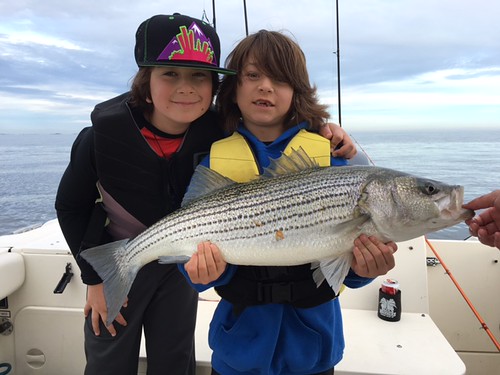
Photo Courtesy of Levi Shum
Freshwater fishing for a variety of fish species continues to be good this week. Colder water temperatures have changed the game quite a bit but anglers can find plenty of action if they follow the fish. Largemouth bass are holding in deeper waters now and are feeding close to the bottom. Fishing along drop-offs and deep structure such as sunken wood, rocks and bridge piers is a good tactic. Slow rolling spinnerbaits along the bottom or working jigs, blade lures and crankbaits close to the bottom will get one to where the fish are holding.
In the upper Potomac River large smallmouth bass are holding in some of the holes behind large rocks that break up the current and walleye are also active. A variety of jigs, crankbaits and jerkbaits are good lures to consider when fishing these areas. Water flows in the upper Potomac are low at this time. At Deep Creek Lake there is still plenty of "soft water" fishing to be found. The fair weather Maryland has been experiencing lately makes it hard not to get out on the lake and enjoy working the mouths of coves and existing grass for a mix of largemouth bass, chain pickerel, northern pike and yellow perch. Crappie are schooled up near the bridge piers and walleye can be found near the steeper rocky shores towards the evenings. It does not look like Deep Creek will be frozen anytime soon but January may be another story.
Recent surveys at Deep Creek Lake by fisheries biologists revealed that the majority of legal sized walleyes in Deep Creek Lake are between 15" and 18" in size. The survey also showed that the yellow perch fish populations are well balanced and smallmouth bass were the third most abundant fish in the lake. Largemouth bass populations continued to show an increase.
The trout management waters that were stocked in October and November still have trout to be caught. Fishing with small lures such as spinners, spoons flies will help one cover more water in search for trout that have spread out. Michael Day was casting a Mepps spinner at Blairs Valley Lake when he caught this nice rainbow trout recently.
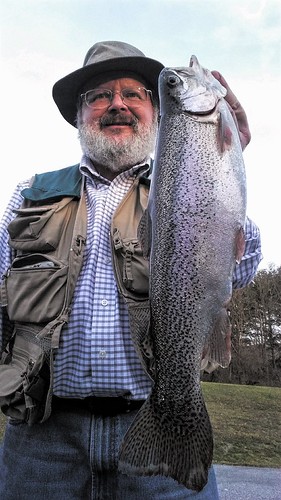
Photo Courtesy of Michael Day
Fisheries Service hatchery staff are busy at the trout hatcheries this month. The next production cycle is underway as trout eggs are being cultured and trout fry are being carefully looked over. The Albert Powell Hatchery received 100, 000 brown trout eggs, 50,000 golden trout eggs and 80,000 rainbow trout eggs in November to get the new production underway for future trout seasons. Trout of all sizes are being reared at the two major hatcheries and also two satellite hatcheries to make sure there are plenty of trout, including the trophy sized trout for the upcoming trout seasons.
Fishing for blue catfish in the tidal Potomac River remains good this week and offers a lot of fishing action and good eating for relatively little effort. Anchoring up near channel edges and fishing with cut bait on a bottom rig is simple fishing. Channel catfish are still active in many of the tidal rivers flowing into the Chesapeake and can be caught on cut bait. Chain pickerel love cold water and are very active in the upper reaches of the tidal rivers and many impoundments throughout Maryland.
Ocean City area fishing continues to be mostly focused on the southerly migration of striped bass and sea bass fishing this week. The migration of large fall migrant striped bass through Maryland waters has been underway for a while now as the fish push south. There is a lot of bait off Ocean City beaches near various shoals and at times the striped bass are there also. Most are trolling large mojos, parachutes and Stretch 25's, jigging or drifting live eels. All know that one must stay within the 3-mile limit and to stay out of the EEZ Zone. Some of the action has been about 2 miles offshore so it pays to be careful and always know your position.
Surf casters have been getting in on some of the action using large cut baits of fresh menhaden or by casting large surface lures or swimming plugs. There is action at the Ocean City Inlet in the evenings and striped bass are being caught most every night on a variety of swim shads, bucktails or by drifting live eels.
The sea bass fishery out at the wreck and reef sites remains very good and limit catches are often the norm. Large bluefish continue to be in the region and continue to attack sea bass being reeled to the surface. Speed reeling is a good option to avoid coming up with just the head of your sea bass. The 2016 tautog season opens on January1st and the 2015 sea bass ends December 31st.
Sunday, November 29, 2015
ASMFC Seeks Proposals for a Socioeconomic Study on Atlantic Menhaden Commercial Fisheries
Arlington, VA – The Atlantic States Marine Fisheries Commission is soliciting proposals from research teams to conduct a socioeconomic study of Atlantic menhaden commercial fisheries. The study, expected to begin in February 2016, is intended to characterize the coastwide commercial fisheries, including bait and reduction sectors and the fishing communities they support. Funding for the project has been provided through a cooperative agreement with NOAA Fisheries. Approximately $80,000 will be available to fund the study.
“We anticipate this project will be key to assisting the Board with future decisions on the management of the menhaden resource,” stated Robert Boyles, Chair of the Commission’s Atlantic Menhaden Management Board. “As such, we are hopeful state agencies and stakeholders will fully and openly participate in the collection of new socioeconomic information. The Board will incorporate the products of the study as it moves forward with the development of Draft Amendment 3 in 2017.”
The primary objective of the study is to provide socioeconomic information to better understand the impacts of potential changes to the management of Atlantic menhaden commercial bait and reduction fisheries. The project will identify individuals, families, firms, organizations, and communities to better characterize the menhaden fisheries and their stakeholders. The study will also gather both primary and secondary information from stakeholders and state agencies on the fisheries (e.g., landings, value, participation, capacity utilization, fixed costs) and market (e.g., retailers/wholesalers, clients/purchasers, number/types of employees) to more thoroughly evaluate the socioeconomic value of Atlantic menhaden.
The research deliverables were identified by the Commission’s Committee on Economics and Social Sciences (CESS) using the general framework from a previous menhaden socioeconomic study conducted in the Chesapeake Bay region by Kirkley and colleagues in 2011. CESS also worked closely with the Atlantic Menhaden Board Allocation Workgroup to address research needs.
“We are excited the Commission was able to secure funding for this in-depth study of the menhaden fishery,” said Madeleine Hall-Arber, CESS Chair. “The effort represents a new direction for the Commission to provide detailed socioeconomic information to help managers better understand management impacts. Similar resources are needed to support socioeconomic studies in other fisheries along the Atlantic Coast.
A full list of the anticipated project deliverables can be found within the Request for Proposals at http://www.asmfc.org/uploads/
Thursday, November 26, 2015
Maryland DNR Fishing Report by Keith Lockwood
There tends to be a little more chill in the air these days as the end of November approaches and Turkey Day is tomorrow. There is good freshwater fishing this week for a variety of species and striped bass fishing in the bay is good. Sea bass fishing off Ocean City is excellent and the fall migration of large striped bass and bluefish into Maryland's coastal waters has begun. Dress warm and enjoy the cool water fishing opportunities we have at the moment.
Striped bass fishing in the upper bay begins in the lower Susquehanna River and extends all the way down to the Bay Bridge this week. There has been plenty of good action in the lower Susquehanna for striped bass above 20" in length and the good action can also be found off Turkey Point and channel edges in the area.
Striped bass are being found along channel edges in the upper bay in about 35' of water mostly by those trolling. They are typically trolling a mixed spread of spoons, swim shads, bucktails dressed with sassy shads and umbrella rigs. Most of the fish being caught range from 20" to 30". There are smaller striped bass in the upper bay but they are usually high in the water column chasing bait. Water temperatures in the upper bay are in the low 50's and even colder in the tidal rivers so most of the better striped bass fishing is occurring out in the bay or the mouths of the rivers. Doug Crowe was trolling an umbrella rig near the mouth of the Magothy when he caught this nice striped bass recently.

Photo Courtesy of Doug Crowe
At the Bay Bridge there continues to be good fishing around the bridge piers for striped bass. Most are jigging soft plastic jigs and bucktails near the pier bases and rock piles. There tends to be a lot of small striped bass in the Bay Bridge area and they can often be seen on top chasing bait. The concrete abutments are a good place to look for a better grade of striped bass holding close to the bottom. There has also been good fishing for white perch at the rock piles. The perch are holding deep and it will take a heavy weight to get to them without being swept off target in the strong currents. A heavy sinker and two dropper flies will usually do the trick.
There continues to be good striped bass fishing at the Kent Narrows for shore bound anglers and for some who wish to break our fishing regulations - it’s too good. Our Natural Resources Police work hard, often at very inconvenient hours to protect our fisheries resources. Three men were charged Thursday with poaching striped bass by officers on an overnight saturation patrol in Kent Narrows. Officers stopped two vehicles under surveillance and found 28 striped bass, 21 of which were undersized. Alejandro Argueta Lanaverde, 38, and Gonzolo Martinez Pena, 46, both of Annapolis, and Franklin Rafael Flores Santos, 27, of Hyattsville, received citations for exceeding the daily creel limit, possessing undersized striped bass and possessing striped bass between midnight and 5 a.m. Santos is scheduled to appear in Queen Anne’s District Court on Jan. 7. The Annapolis men have a Feb. 4 court date. If found guilty, each man could be fined as much as $3,000.
In the middle bay region trolling has become very popular along channel edges in the main bay such as the 30'to 35' edges on the western side of the shipping channel from Breezy Point south past Parkers Creek to Cove Point. Most boats are pulling a mixed spread of lures at various depths using inline weights of various sizes. Umbrella rigs have been popular with trailing bucktails dressed with sassy shads or Storm type lures. Spoons have been a good choice as has tandem rigged bucktails. Most of the larger fish are coming from deeper depths and it is a good way to avoid the smaller striped bass that tend to be higher in the water column. Sam Schatz holds up two nice striped bass caught while trolling along the western edge of the shipping channel below Breezy Point.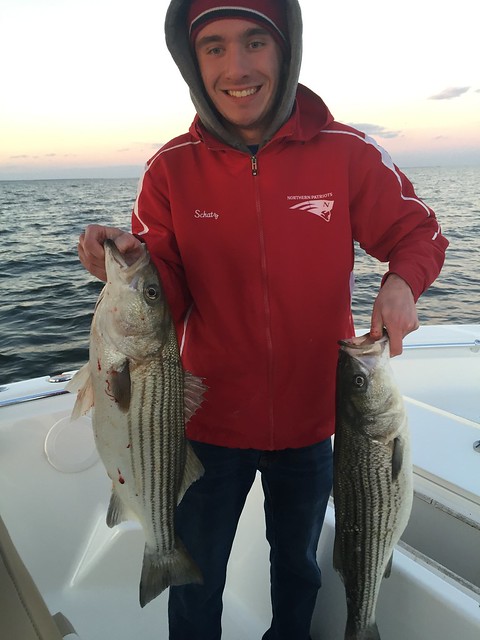

Photo by Travis Long
Breaking fish are being encountered throughout the region; with most of the action for larger fish occurring in the bay. There is still some spotty action in the tidal rivers but it is usually smaller striped bass with a few larger fish underneath the surface action at times. Jigging is one of the most popular ways for small boat anglers to fish when breaking fish can be spotted to get to those larger fish. Larger striped bass are being spotted on depth finders, suspended out in the bay along channel edges and oyster bars. Metal jigs combined with braided line and a fast action rod tends to be a favorite but soft plastic jigs work well also. The water clarity in the middle bay region continues to be extremely good, bay water temperatures are about 55° and the salinity is elevated at18 parts per thousand. Water temperatures are noticeably cooler in the tidal rivers.
In the lower bay breaking striped bass are being encountered throughout the entire region with the bulk of the action occurring from the Middle Grounds area to the west side of Point Lookout. Most are jigging underneath the smaller striped bass which tend to be at the surface in search of a larger grade of fish. In the area from lower Hooper's Island to buoy 72A more than a few fishermen are reporting striped bass in the size range of 20" to 32" being caught by jigging and trolling. The channel cuts through lower Hooper's Island have been a good place to cast soft plastics and bucktails and bounce them along the bottom to striped bass that are holding there. There is also a shallow water bite in the early mornings and evenings along the marsh shorelines of the Eastern Shore. Casting swim shad type lures or topwater lures has been the ticket to this late season show. There continues to be some sea trout in the area and most are being caught while jigging.
Those who are trolling are using a mixed spread of umbrella rigs with bucktail or swim shad trailers behind inline weights along with spoons and tandem rigged bucktails dressed with sassy shads. As of this week, there have been a few reports of large fall migrant striped bass making their way up the bay into Maryland waters. The bulk of the fall coastal migration of large striped bass is in New Jersey and the vanguard is now just entering Maryland waters. There were two large fish in the 47" size range reported during during last weekend's MSSA Tournament and Jason Zagalsky and crew caught and released this big 47" striped bass last Thursday just a few days before the tournament.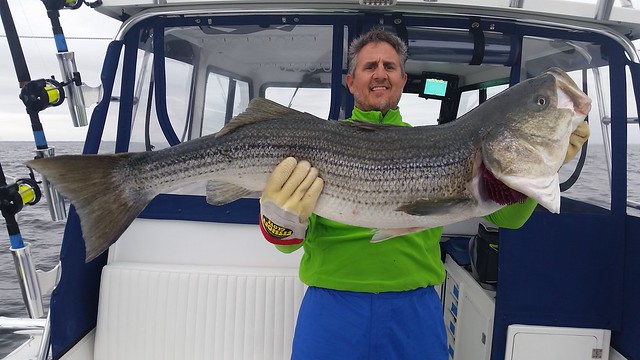

Photo Courtesy of Jason Zagalsky
Freshwater anglers at Deep Creek Lake are beginning to buzz about hopes of the lake icing over and a fun season of ice fishing. Until then there is plenty of good fishing to be had while the lake waters are clear of ice. There is good fishing for a mix of largemouth bass, smallmouth bass and large yellow perch in the upper lake areas where deep grass remains. Northern pike and chain pickerel are plentiful in the mouths of coves around the remaining grass beds also. There is good fishing for walleyes at dusk along some of the steeper rocky shorelines and most are casting swimming minnow type lures with good success.
The upper Potomac River continues to be low with very clear water; water temperatures are in the upper 40's. Smallmouth bass and walleye are scattered in the middle part of the river with the larger smallmouth bass concentrating in what is often termed "winter spots". These are the deeper areas that have large boulders to break up the current flow during high flow conditions. Soft plastic jigs, tubes and small crankbaits are good choices in these areas. The smaller smallmouth bass are becoming mostly dormant now with colder water temperatures so gear up for the larger fish.
Largemouth bass fishing remains good in the ponds, lakes and tidal waters this week. The bass are holding in deeper waters now near drop-offs. They are busy feeding on small baitfish and crayfish that are moving from the shallower areas where grass is breaking up to deeper cover such as sunken wood and rocks. Slow rolling spinnerbaits close to the bottom or working small crankbaits and jigs in similar fashion is a good bet. Working sunken wood and structure such as bridge piers and rocks is also a good strategy.
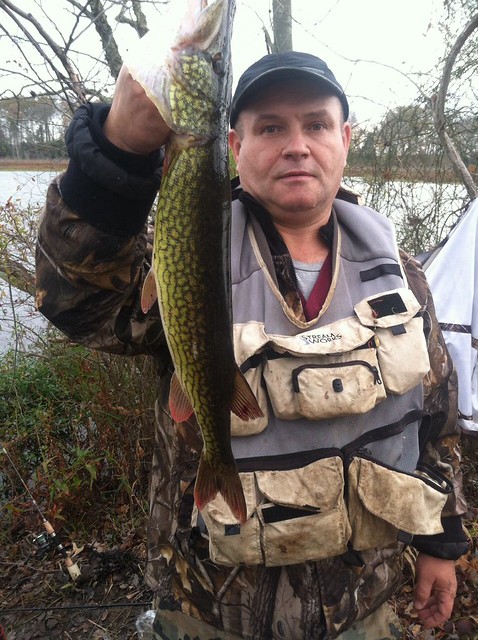 Crappie are schooled up now in deeper waters near structure. Bridge piers, marina docks and sunken brush or rocks are a good place to fish. Small jigs or minnows under a slip bobber are a good tactic. Channel catfish are active in most of the tidal rivers of the Chesapeake and blue catfish are plentiful and active in the tidal Potomac River. Chain pickerel are active and with grass beds diminishing, the pickerel and other fish are more accessible. Myroslav Tarnovetskyy was fishing in Tuckahoe Lake when he hooked this Maryland Fishing Challenge award size chain pickerel.
Crappie are schooled up now in deeper waters near structure. Bridge piers, marina docks and sunken brush or rocks are a good place to fish. Small jigs or minnows under a slip bobber are a good tactic. Channel catfish are active in most of the tidal rivers of the Chesapeake and blue catfish are plentiful and active in the tidal Potomac River. Chain pickerel are active and with grass beds diminishing, the pickerel and other fish are more accessible. Myroslav Tarnovetskyy was fishing in Tuckahoe Lake when he hooked this Maryland Fishing Challenge award size chain pickerel.
Photo Courtesy of Myroslav Tarnovetskyy
Trout fishing remains very good this week in many of the states trout management waters. There are still good numbers of trout in many of the put and take management waters. Casting spinners, small spoons and flies are a good way to cover plenty of water to find those trout that have been dodging Powerbaits. The catch and release and fly fishing only trout management waters are offering excellent trout fishing opportunities this week.
The Ocean City area is beginning to see the first substantial numbers of large migrant striped bass entering Maryland waters this week and this coming weekend may give anglers their first licks at these beautiful fish as they pass by on their way south. Surf casters will be fishing with fresh menhaden baits on bottom rigs; boats will be trolling the near shore shoal areas with Stretch 25 lures, bucktails, umbrella rigs or will be seen jigging or fishing with live eels. At the inlet casting bucktails or drifting live eels will be popular in the evenings. There are a lot of large bluefish in the region and more to come so they are part of the equation.
Sea bass fishing has been very good on the offshore wreck and reef sites with limits around the rails of party boats a common occurrence. Large bluefish are present and making short work of sea bass being reeled in, so speed reeling your valuable catch is in order.
Tautog fishing has been good on the inshore wreck sites and at the Route 50 Bridge/inlet complex. There are a lot of throwbacks inside the inlet area but keepers are present. Pieces of green crab and sand fleas are the best baits. Tautog season closes tomorrow November 26th.
Thursday, September 24, 2015
Labels:
Cup,
fishing,
Little Havana,
Rocktober,
tournament
Wednesday, September 9, 2015
Entries now open for HUK-CCA Red Trout tourney
CRISFIELD — Anglers
can now sign up for the third annual Huk Performance Fishing-CCA Red
Trout Catch & Release Tournament, Sept. 18-20 in Crisfield.
The
tournament, headquartered at Somers Cove Marina, will host many of
our region'’s top light tackle, fly, and kayak anglers. This year a
live bait category has been added. The tourney promotes sustainable,
catch-and-release fishing methods where anglers photograph their
catch for digital submittals in lieu of a weigh in.
“The
Crisfield/Tangier Sound area boasts some of the best redfish and
speckled trout fishing on the Eastern Seaboard. Winners will be
selected based on the total length of their three longest fish caught
Saturday and Sunday. At least one of those three fish must be a
speckled trout or redfish. The remaining two can be a striped bass,
flounder, bluefish, or additional speckled trout and redfish.
Categories
include a boat division for bait and light tackle anglers and
individual divisions for fly and kayak anglers. Boat teams will
consist of two fishermen. All entrants must attend check-in meetings
Friday and Saturday nights where food will be served.
All
rules and registration information can be found on the CCA MD
website, www.ccmd.org.
The
tournament was founded in 2013 to draw attention to the value of
redfish and speckled trout that recently have been making a comeback
in the Chesapeake Bay.
Saturday, March 29, 2014
Maryland/Chesapeake Bay Fishing Report March 26, 2014
Maryland Weekly Fishing Report Overview | March 26, 2014

Courtesy of John Mullican

Courtesy of Benjamin Powell
This Saturday is the big one for put and take trout fishermen; for outdoorsmen whether they be a hunter or fisherman or both there is nothing that tugs at the child inside of us as much as the thought of opening day. Many will find it hard to sleep the night before and there will be plenty of glances at the bedside alarm clock during the night. For those with young anglers in the house, enjoy and bath yourself in all the excitement and anticipation and for those older, find comfort in spending time with your old fishing buddy. Fishermen have been checking out their gear and tackle shop shelves for weeks now and it all comes to fruition this coming Saturday. Parking and the best streamside fishing spots will be at a premium as will dry feet and the rest of you unless you dress properly because the weatherman is telling us there is a 70% chance of rain.
Despite a late start due to ice conditions at the trout holding facilities the stocking crews have been very busy making sure all areas that are due to be stocked for this Saturday's opener have a generous supply of trout. John Mullican sent in these pictures of stocking trout during yesterday's snow storm; all in a day's work of being a fisheries biologist.
Courtesy of John Mullican
Most likely wherever you decide to fish you may hear some whoops, hollers and excitement at some point when someone catches one of the trophy sized breeder trout that are placed at every trout management area. May luck be on your side and you are the person who manages to heft one of these beasts up onto the bank. If you do catch a Rainbow Trout over 20- inches visit one of our award centers and register your trophy to receive a certificate and entry into the Maryland Fishing Challenge. Entrants are eligible to win several large prizes including a boat, motor and trailer donated by Bass Pro Shops. To find out about theMaryland Fishing Challenge and how to enter, be sure to check out the website.
Freshwater fishermen have had other types of fishing on their minds as well as trout for the last few weeks and have been testing out their favorite fishing holes for a mix of species. If you check the angler's logs you will see a wide variety of fishing opportunities even though it has been cold.
Chain Pickerel are a fun target for fishermen when the water is cold and ponds normally clogged with vegetation in the summer months are open and near snag free. Spinners, swimming minnow lures and spoons are all good early spring choices for Chain Pickerel. Bank and small boat fishermen have been enjoying good fishing for Channel Catfish in the tidal rivers. Crappie can be found holding near structure near deep edges and Largemouth Bass are being found in transition areas looking for a little warmth. A small jig or minnow under a bobber works great for crappie and Largemouth Bass will strike a variety of soft plastic jigs and crankbaits this time of the year. Although the upper Potomac has been running a bit high and cloudy lately, fishermen have been enjoying some good fishing for Walleye and Smallmouth Bass. The best fishing tends to be in the eddy areas where fish are holding out of the strong currents. Small jigs, tubes and sassy shad type lures have been good choices for fishing close to the bottom. Benjamin Powell was fishing from the shoreline when he caught this nice Walleye and others on the upper Potomac recently.
Courtesy of Benjamin Powell
It has been quite a spring so far as cold water temperatures have caused expected spawning runs to be delayed and fast paced when a day or two of relative warm and sunny days causes spawning to bust loose. The Yellow Perch spawning runs are over for the most part now and fishermen saw White Perch arriving at traditional spawning areas over the past weekend. Yesterday's snow and cold temperatures put the skids on most spawning activity but predicted warmer weather for the next week will put White Perch spawning into high gear. There may be a little lag time as water temperatures are slow to change and melting snow will also be bringing an influx of cold water into the spawning reaches of the tidal rivers. Fishermen may find that the top of the flood tide might bring in the warmest water temperatures and therefore cause the White Perch to be the most active. A small chartreuse grub, crappie jig or shad dart tipped with a piece of bloodworm or grass shrimp and under a bobber is hard to beat when fishing in close quarters for White Perch.
Water temperatures today are hovering around the 43-degree mark in the lower Susquehanna River and the Conowingo Dam has been releasing water as much as twice per day. Snow melt is not going to be helpful for elevating water temperatures so it will take a few days at best for the White Perch fishery to begin to show some signs of life. Despite cold water temperatures there are Striped Bass in the Susquehanna Flats area and most likely many of them will be males. It will take some warmer water temperatures to put any of them in a feeding mood.
Fishermen looking to shake the cobwebs out of their fishing gear and boats with a little Striped Bass catch and release fishing out in the bay may find it hard to find ready and willing fish; water temperatures are still in the high 30's on top and the bottom for most of the bay. There has been very little activity reported at the Calvert Cliffs Power Plant discharge by drift and jig fishermen. There were reports of some Striped Bass action in the lower Potomac River but were not large migrant fish coming into the bay but smaller resident fish. It would be safe to assume that when things do warm up a bit any large Striped Bass moving up the bay will be near the warmer surface water.
Most Ocean City area fishermen have been sitting it out for the most part. Most captains still feel the water is too cold for a good Tautog bit on the inshore and offshore wreck sites and the Black Sea Bass season doesn't open until May 19th. There was some talk among locals of some large Speckled Trout caught recently in the coastal bays.
Subscribe to:
Comments (Atom)

